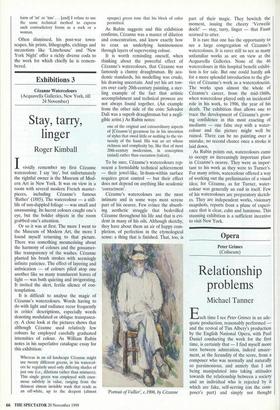Exhibitions 3
Cezanne Watercolours (Acquavella Galleries, New York, till 24 November)
Stay, tarry, linger
Roger Kimball
Ivividly remember my first Cezanne watercolour. I say 'my', but unfortunately the rightful owner is the Museum of Mod- ern Art in New York. It was on view in a room with several modem French master- pieces, including Cezanne's famous 'Bather' (1885). The watercolour — a still- life of sun-dappled foliage — was small and unassuming. Its lucent colours caught one's eye, but the bolder objects in the room grabbed one's attention.
Or so it was at first. The more I went to the Museum of Modern Art, the more I found myself returning to that picture. There was something mesmerising about the harmony of colours and the gossamer- like transparency of the washes. Cezanne planted his brush strokes with seemingly infinite patience. The effect of layering and imbrication— of colours piled atop one another like so many translucent leaves of light — was both quieting and invigorating. It invited the alert, fertile silence of con- templation.
It is difficult to analyse the magic of Cezanne's watercolours. Words having to do with light and radiance recur frequently in critics' descriptions, especially words denoting modulated or oblique transparen- cy. A close look at the pictures shows that although Cezanne used relatively few colours he employed carefully graduated intensities of colour. As William Rubin notes in his superlative catalogue essay for this exhibition:
Whereas in an oil landscape Mune might use twenty different greens, in his watercol- ors he regularly used only differing shades of just one (i.e., dilutions rather than mixtures). This single green was employed with enor- mous subtlety in value, ranging from the thinnest almost invisible wash that reads as an off-white, up to the deepest (almost opaque) green tone that his block of color permitted.
As Rubin suggests and this exhibition confirms, Cezanne was a master of dilution and concentration, and knew exactly bow to coax an underlying luminousness through layers of supervening colour.
It is worth reminding oneself, when thinking about the powerful effect of Cezanne's watercolours, that Cezanne was famously a clumsy draughtsman. By aca- demic standards, his modelling was crude, his drawing uncertain. And yet his art tow- ers over early 20th-century painting, a ster- ling example of the fact that artistic accomplishment and technical prowess are not always found together. (An example from the other side of the coin: Salvador Dali was a superb draughtsman but a negli- gible artist.) As Rubin notes:
one of the original and extraordinary aspects of [Cezanne's] greatness lay in his invention of styles that owed little or nothing to the vir- tuosity of the hand. His was an art whose richness and complexity lay, like that of most 20th-century modernism, in conception (mind) rather than execution (talent).
To be sure, Cezanne's watercolours rep- resent a formidable technical achievement — their jewel-like, lit-from-within surface requires great control — but their effect does not depend on anything like academic 'correctness'.
Cezanne's watercolours are the most intimate and in some ways most serene part of his oeuvre. Few evince the absorb- ing aesthetic struggle that bedevilled Cezanne throughout his life and that is evi- dent in many of his oils. Although sketchy, they have about them an air of happy com- pletion, of perfection in the etymological sense: a thing that is finished. That, too, is 'Portrait of Vanier, c.I906, by Monne part of their magic. They bewitch the moment, issuing the cheery 'Verweile doch!' — stay, tarry, linger — that Faust scorned to utter.
It is rare that one has the opportunity to see a large congregation of Cezanne's watercolours. It is rarer still to see as many unfamiliar works as are on view at the Acquavella Galleries. None of the 46 watercolours in this hospital benefit exhibi- tion is for sale. But one could hardly ask for a more splendid introduction to the glo- ries of Cezanne's work as a watercolourist. The works span almost the whole of Cezanne's career, from the mid-1860s, when watercolour played only an incidental role in his work, to 1906, the year of his death. The exhibition thus allows one to trace the development of Cezanne's grow- ing confidence in this most exacting of mediums — one false step with a water- colour and the picture might well be ruined. There can be no painting over a mistake, no second chance once a stroke is laid down.
As Rubin points out, watercolours came to occupy an increasingly important place in Cezanne's oeuvre. They were as impor- tant to his work as they were to Turner's. For many artists, watercolour offered a way of working out the preliminaries of a visual idea; for Cezanne, as for Turner, water- colour was generally an end in itself. Few of his watercolours are preparatory sketch- es. They are independent works, visionary snapshots, reports from a plane of experi- ence that is clear, calm and luminous. This stunning exhibition is a sufficient incentive to visit New York.


























































































 Previous page
Previous page